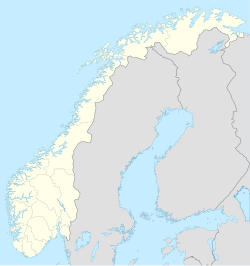Geiranger
Geiranger | |
|---|---|
Village | |
 Geiranger and Geirangerfjord from Flydalsjuvet | |
 | |
| Coordinates: 62°06′07″N 7°12′26″E / 62.1019°N 7.2072°E | |
| Country | Norway |
| Region | Western Norway |
| County | Møre og Romsdal |
| District | Sunnmøre |
| Municipality | Stranda Municipality |
| Area | |
• Total | 0.34 km2 (0.13 sq mi) |
| Elevation | 16 m (52 ft) |
| Population (2023)[1] | |
• Total | 215 |
| • Density | 632/km2 (1,640/sq mi) |
| Time zone | UTC+01:00 (CET) |
| • Summer (DST) | UTC+02:00 (CEST) |
| Post Code | 6216 Geiranger |
Geiranger[3] is a small tourist village in Sunnmøre region of Møre og Romsdal county in the western part of Norway. It is located in Stranda Municipality at the head of the Geirangerfjorden, which is a branch of the large Storfjorden. The nearest city is Ålesund. Geiranger is home to spectacular scenery, and has been named the best travel destination in Scandinavia by Lonely Planet. Since 2005, the Geirangerfjord area has been listed as a UNESCO World Heritage Site.[4][5]
Norwegian County Road 63 passes through the village. Geiranger Church is the main church for the village and surrounding area. The 0.34-square-kilometre (84-acre) village had a population (2023) of 215 and a population density of 632 inhabitants per square kilometre (1,640/sq mi). Since 2000, the population and area data for this village area has not been separately tracked by Statistics Norway.[1]
Geiranger is under constant threat from landslides from the mountain Åkerneset into the fjord. A collapse would cause a megatsunami that could destroy the village of Geiranger. For this reason, sirens have been installed to warn residents if a landslide should occur.
Name
[edit]The Old Norse form of the name was Geirangr. The suffix angr (which means "fjord") is a common element in Norwegian place names (such as Hardanger and Varanger).[6][7] The first element could be the plural genitive of the Old Norse word geiri (which means "a piece of land" or "a field in a mountain side") which is related to the Middle English word gore (meaning a "spear-shaped piece of land"). This would then refer to the several small farms and fields lying in the steep mountain sides around the fjord (such as Knivsflå and Skageflå).
Tourism
[edit]This third biggest cruise ship port in Norway, Geiranger receives 140 to 180 ships during the four-month tourist season. In 2012 some 300,000 cruise passengers visited Geiranger during the summer season.[8] The Geiranger Port has a cruise terminal, a Seawalk, and 3–4 anchor positions depending on the size of the ships. Constructed in 2013, the Seawalk is a three-segment articulated floating pier. It is 236 metres (774 ft) long and 4.5 metres (15 ft) wide on 10 pontoons, which moves (like a floatable jetwalk) to accommodate up to 4,000 passengers per hour disembarking from a single ship.[9]
Several hundred thousand people pass through the village every summer, and tourism is the main business for the 250 people who live there permanently. There are four hotels and over ten camping sites. The tourist season stretches from May to early September. Tours of the nearby historic farms of Knivsflå and Skageflå are available from Geiranger. The Seven Sisters waterfall is located just west of Geiranger, directly across another waterfall called "The Suitor."
Each year in June, the Geiranger – From Fjord to Summit event occurs. It comprises a half marathon run and a bicycle race, both starting from the sea level at the fjord and ending at the 1,497-metre (4,911 ft) summit of Mount Dalsnibba, near the lake Djupvatnet. Since there is still a lot of snow left in the mountains at that time of year, the race is also called "From Summer to Winter".
Nearest airport is Ørsta-Volda Airport, Hovden around 1 hour and 50 min away.
Media gallery
[edit]-
The seven sisters waterfall over Geirangerfjord
-
View of the village of Geiranger
-
Storfossen falls in Geiranger
-
Fishermen houses
-
Cabins around Geiranger
-
View of the Geirangerfjord
-
The coastal express passes the old fjord farm Lundaneset
-
View of the fjord and of Geiranger from Flydalsjuvet
-
Geiranger movable Seawalk on pontoons
In popular culture
[edit]- Released in August 2015, The Wave (Norwegian: Bølgen) is a Norwegian disaster movie based on the premise of a rock slide from the mountain Åkerneset inundating the town of Geiranger.[10] A sequel,The Quake (Norwegian: Skjelvet) was released in 2018.
References
[edit]- ^ a b c Statistisk sentralbyrå (2022-04-03). "04859: Area and population of urban settlements (US) 2000 - 2021".
- ^ "Geiranger, Stranda (Møre og Romsdal)". yr.no. Retrieved 2019-08-25.[permanent dead link]
- ^ "Informasjon om stadnamn". Norgeskart (in Norwegian). Kartverket. Retrieved 2025-04-17.
- ^ Placeaholic. "20 Things To Do And Best Places to Take Photos In Norway". Retrieved 2016-05-18.
- ^ Thorsnæs, Geir, ed. (2024-12-19). "Geiranger (tettstad)". Store norske leksikon (in Norwegian). Foreningen Store norske leksikon. Retrieved 2025-04-16.
- ^ Rygh, Oluff (1896). Norske Fjordnavne (in Norwegian). Kristiania: Aschehoug.
- ^ Helle, Knut (1975). Stavanger: fra våg til by (in Norwegian). Stavanger: Stabenfeldt. ISBN 8253201893.
- ^ "Geiranger". Dagens Næringsliv (in Norwegian). 12 October 2012. p. 26.
- ^ "Geiranger Port and Hellesylt Port". stranda-hamnevesen.no. Retrieved 27 July 2017.
- ^ Nemiroff, Perri (17 September 2015). "'The Wave' Review: Puts Hollywood Disaster Movies to Shame". Collider. Retrieved 15 December 2020.
External links
[edit]- geiranger.no
- Geiranger Fjord Archived 2019-06-05 at the Wayback Machine—David Cartagena print
- Destinasjon Geirangerfjord—Trollstigen Archived 2016-05-08 at the Wayback Machine
- Image from Geiranger
- Geiranger—From Fjord to Summit
- UNESCO World Heritage
- Geiranger in 360 degree VR panorama










